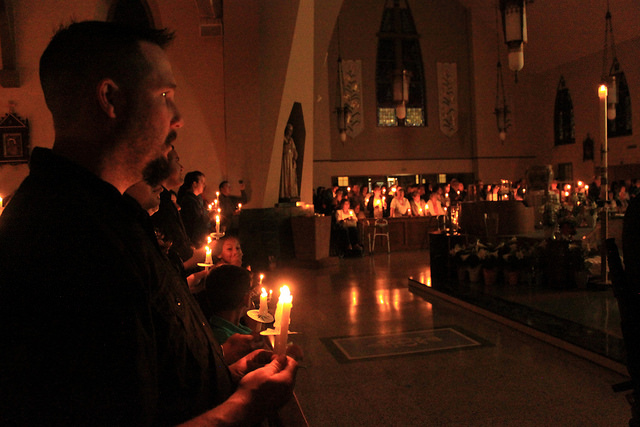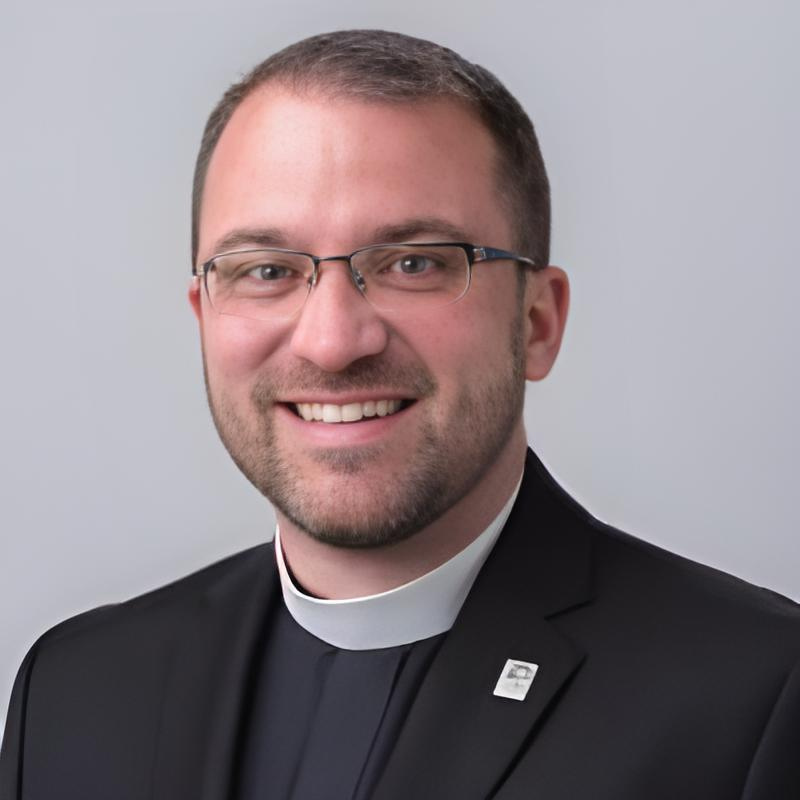We gather in old and new ways, and in new and old ways, holding vigil and celebrating Easter. We gather as our forefathers and -mothers of the faith have for almost two thousand years. We gather in darkness of night, a darkness that contains, still, Good Friday. We gather around fire. We light candles. We tell our favorite stories of the faith, stories that remind us of salvation history and our place in that history. We sing. We pray. We welcome new converts to the faith through the waters of baptism. We eat of Christ.
The Vigil is an opportunity to proclaim the mystery of our faith: “Christ has died. Christ has risen. Christ will come again.” We loudly proclaim in our singing and in our praying that “This is the night.” This is the night that we stand in the liminal space and find ourselves in deep paradox that holds the greatest of life’s promises. Augustine called this creative holding of both death and resurrection at the same time “the Paschal Mystery,” the place where all transformation happens, the liminal space where God holds paradox.
Working Preacher commentaries |
Old Testament readings (selected)*
|
New Testament reading |
Gospel reading
* Selected Old Testament Vigil readings from Evangelical Lutheran Worship (Augsburg Fortress, 2006), 269. |
It is said that on Good Friday, we preach Easter and that on Easter we preach Good Friday. So how does one preach the vigil of Easter? In the fourth century, John Chrysostom preached at the vigil and offered early preachers some good advice; advice that may help you, dear preachers, as you welcome many into mystery of this night. Chrysostom helped his gathered assembly to enter into the vigil and not to be intimidated by it.
“So, all of you, enter into the joy of the Lord: first and second, share the bounty. Rich and poor alike, celebrate together. Sober or headless, honor the day. No one need lament poverty, for the kingdom is seen as universal. No one need grieve over sins; forgiveness has dawned from the tomb. No one need fear death; the Savior’s death has freed us from it. Christ, having risen from the dead, has become the first fruits of those that slept. To him be glory and the dominion, forever. Amen.”1
This is the night that we who have the profound opportunity to proclaim good news, are able to connect our story with God’s story. We are able to remind the world that no one need fear death. We are able to remind the world that death does not have the last word. We have the opportunity to connect the stories of our faith throughout salvation history that are read this night.
For you see our story can never been seen as a separate story from God’s story. From the moment we were born anew in baptism, our stories have been dancing with one another in a fantastic waltz of love. The vigil of Easter is a wonderful opportunity to be reminded how our stories have been merged together.
When we are baptized we are enclosed into the tomb that shatters sin and death and when the stone rolls away, when the waters wash over our heads and our bodies are brought forth, we rise a new person, a person whose story is forever part of God’s great love story.
Dear preacher, for this to be such good news, how come we do not live as resurrected Easter people, but people collapsed by fear, people who are like the guards at the tomb, numbed fear? Could it really be that living in a tomb is happier, clearer and more promising than rolling away the stone?
Surely that was not the case for Jesus and should not be the same for us.
How do we help those who attend the vigil hear the word of promise and hope this night?
On that holy night, so long ago, vigil was kept, but work of resurrection and new life was taking place.
The same is true for us. This is the night! This is the night, when we are reminded that God has not brought us this far by faith to leave us. This is the night that we hear salvation history, our history spoken, as the Exultant proclaims: “This indeed is the Paschal Feast in which the Lamb is slain, by whose blood the doorposts of the faithful are made holy. This is the night in which, in ancient times, you delivered our forebearers, the children of Israel, from the land of Egypt; and led them, dry-shod, through the Red Sea.”
Our salvation present and future promises are spoken: “This is the night in which all who believe in Christ are rescued from evil and the gloom of sin; and are renewed in grace and are restored to holiness. This is the night in which, breaking the chains of death, Christ arises from hell in triumph.”2
Preaching the vigil is an opportunity to proclaim the mystery of our faith, without exegeting each text read, or a didactic approach that unpacks all the 2000-year history of the vigil. Less is more!
This is the night: the night that our story becomes God’s story, our “once upon a time” is joined to a “once upon a time” two thousand years ago.
Blessings on your proclamation!
Notes
1. “Paschal Sermon of St. John Chrysostom.” The sermon is read every year at the Easter Vigil in many Orthodox congregations. Taken from Reformed Worship Number 54 (December 1999) by Faith Alive Christian Resources. Copyright 1999. Used by permission of Faith Alive Christian Resources.
2. “Lent and the Three Day: Vigil of Easter,” Evangelical Lutheran Worship: Leaders Desk Edition, (Augsburg Fortress, 2006).

